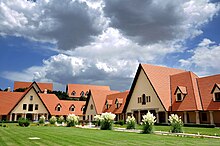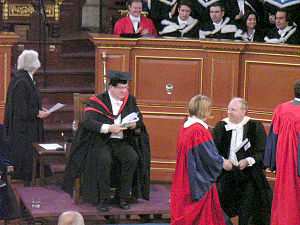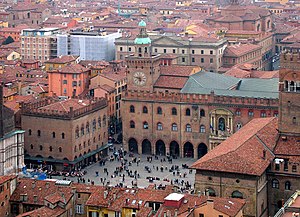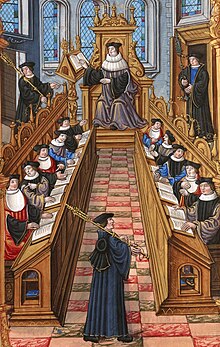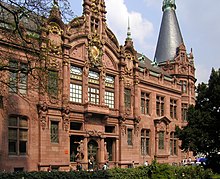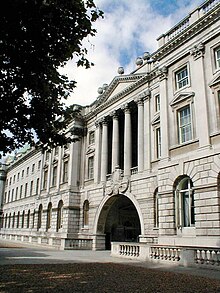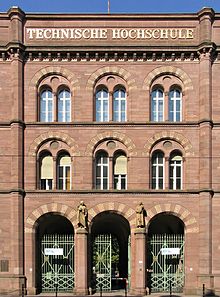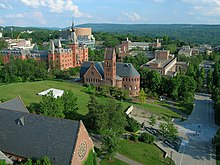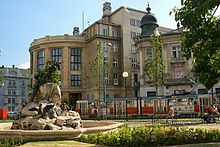From Wikipedia, the free encyclopedia
The word
university is derived from the
Latin universitas magistrorum et scholarium, which roughly means "community of teachers and scholars". While antecedents had existed in Asia and Africa, the modern university system has roots in the European
medieval university, which was created in Italy and evolved from
cathedral schools for the clergy during the
High Middle Ages.
History
Definition
The original
Latin word
universitas refers in general to "a number of persons associated into one body, a society, company, community, guild,
corporation, etc". At the time of the emergence of urban town life and
medieval guilds, specialized "associations of
students and
teachers
with collective legal rights usually guaranteed by charters issued by
princes, prelates, or the towns in which they were located" came to be
denominated by this general term. Like other guilds, they were
self-regulating and determined the qualifications of their members.
In modern usage the word has come to mean "An institution of
higher education offering tuition in mainly non-vocational subjects and
typically having the power to confer degrees," with the earlier emphasis on its corporate organization considered as applying historically to Medieval universities.
The original Latin word referred to degree-awarding institutions of learning in
Western and
Central Europe, where this form of legal organisation was prevalent and from where the institution spread around the world.
Academic freedom
An important idea in the definition of a university is the notion of
academic freedom. The first documentary evidence of this comes from early in the life of the
University of Bologna, which adopted an academic charter, the
Constitutio Habita, in 1158 or 1155,
which guaranteed the right of a traveling scholar to unhindered passage
in the interests of education. Today this is claimed as the origin of
"academic freedom". This is now widely recognised internationally - on 18 September 1988, 430 university rectors signed the
Magna Charta Universitatum, marking the 900th anniversary of Bologna's foundation. The number of universities signing the
Magna Charta Universitatum continues to grow, drawing from all parts of the world.
Antecedents
Their endowment by a prince or monarch and their role in training government officials made early
Mediterranean universities similar to Islamic
madrasas,
although madrasas were generally smaller, and individual teachers,
rather than the madrasa itself, granted the license or degree. Scholars like
Arnold H. Green and
Hossein Nasr have argued that starting in the 10th century, some
medieval Islamic madrasas became universities. However, scholars like
George Makdisi, Toby Huff and Norman Daniel argue that the European university has no parallel in the medieval Islamic world. Several other scholars consider the university as uniquely European in origin and characteristics. Darleen Pryds questions this view, pointing out that
madaris
and European universities in the Mediterranean region shared similar
foundations by princely patrons and were intended to provide loyal
administrators to further the rulers' agenda.
Some scholars, including Makdisi, have argued that early medieval universities were influenced by the madrasas in
Al-Andalus, the
Emirate of Sicily, and the Middle East during the
Crusades. Norman Daniel, however, views this argument as overstated.
Roy Lowe and Yoshihito Yasuhara have recently drawn on the
well-documented influences of scholarship from the Islamic world on the
universities of Western Europe to call for a reconsideration of the
development of higher education, turning away from a concern with local
institutional structures to a broader consideration within a global
context.
Medieval universities
The University of Bologna in Italy, founded in 1088, is the oldest university, the word university (Latin: universitas) having been coined at its foundation.
The University of Bologna began as a law school teaching the
ius gentium or
Roman law
of peoples which was in demand across Europe for those defending the
right of incipient nations against empire and church. Bologna's special
claim to
Alma Mater Studiorum
is based on its autonomy, its awarding of degrees, and other structural
arrangements, making it the oldest continuously operating institution independent of kings, emperors or any kind of direct religious authority.
The conventional date of 1088, or 1087 according to some, records when
Irnerius commences teaching
Emperor Justinian's 6th century codification of Roman law, the
Corpus Iuris Civilis,
recently discovered at Pisa. Lay students arrived in the city from many
lands entering into a contract to gain this knowledge, organising
themselves into 'Nationes', divided between that of the Cismontanes and
that of the Ultramontanes. The students "had all the power … and
dominated the masters".
All over Europe rulers and city governments began to create
universities to satisfy a European thirst for knowledge, and the belief
that society would benefit from the scholarly expertise generated from
these institutions. Princes and leaders of city governments perceived
the potential benefits of having a scholarly expertise develop with the
ability to address difficult problems and achieve desired ends. The
emergence of humanism was essential to this understanding of the
possible utility of universities as well as the revival of interest in
knowledge gained from ancient Greek texts.
The rediscovery of
Aristotle's
works–more than 3000 pages of it would eventually be translated–fuelled
a spirit of inquiry into natural processes that had already begun to
emerge in the 12th century. Some scholars believe that these works
represented one of the most important document discoveries in Western
intellectual history. Richard Dales, for instance, calls the discovery of Aristotle's works "a turning point in the history of Western thought."
After Aristotle re-emerged, a community of scholars, primarily
communicating in Latin, accelerated the process and practice of
attempting to reconcile the thoughts of Greek antiquity, and especially
ideas related to understanding the natural world, with those of the
church. The efforts of this "
scholasticism"
were focused on applying Aristotelian logic and thoughts about natural
processes to biblical passages and attempting to prove the viability of
those passages through reason. This became the primary mission of
lecturers, and the expectation of students.
The university culture developed differently in northern Europe than
it did in the south, although the northern (primarily Germany, France
and
Great Britain)
and southern universities (primarily Italy) did have many elements in
common. Latin was the language of the university, used for all texts,
lectures,
disputations and examinations. Professors lectured on the books of Aristotle for logic,
natural philosophy, and
metaphysics; while
Hippocrates,
Galen, and
Avicenna
were used for medicine. Outside of these commonalities, great
differences separated north and south, primarily in subject matter.
Italian universities focused on law and medicine, while the northern
universities focused on the arts and theology. There were distinct
differences in the quality of instruction in these areas which were
congruent with their focus, so scholars would travel north or south
based on their interests and means. There was also a difference in the
types of degrees awarded at these universities. English, French and
German universities usually awarded bachelor's degrees, with the
exception of degrees in theology, for which the doctorate was more
common. Italian universities awarded primarily doctorates. The
distinction can be attributed to the intent of the degree holder after
graduation – in the north the focus tended to be on acquiring teaching
positions, while in the south students often went on to professional
positions. The structure of northern universities tended to be modeled after the system of faculty governance developed at the
University of Paris. Southern universities tended to be patterned after the student-controlled model begun at the University of Bologna.
Among the southern universities, a further distinction has been noted
between those of northern Italy, which followed the pattern of Bologna
as a "self-regulating, independent corporation of scholars" and those of
southern Italy and Iberia, which were "founded by royal and imperial
charter to serve the needs of government."
Early modern universities
During the
Early Modern period
(approximately late 15th century to 1800), the universities of Europe
would see a tremendous amount of growth, productivity and innovative
research. At the end of the Middle Ages, about 400 years after the first
European university was founded, there were twenty-nine universities
spread throughout Europe. In the 15th century, twenty-eight new ones
were created, with another eighteen added between 1500 and 1625.
This pace continued until by the end of the 18th century there were
approximately 143 universities in Europe, with the highest
concentrations in the German Empire (34), Italian countries (26), France
(25), and Spain (23) – this was close to a 500% increase over the
number of universities toward the end of the Middle Ages. This number
does not include the numerous universities that disappeared, or
institutions that merged with other universities during this time.
The identification of a university was not necessarily obvious during
the Early Modern period, as the term is applied to a burgeoning number
of institutions. In fact, the term "university" was not always used to
designate a higher education institution. In
Mediterranean countries, the term
studium generale was still often used, while "Academy" was common in Northern European countries.
The propagation of universities was not necessarily a steady
progression, as the 17th century was rife with events that adversely
affected university expansion. Many wars, and especially the
Thirty Years' War, disrupted the university landscape throughout Europe at different times.
War,
plague,
famine,
regicide,
and changes in religious power and structure often adversely affected
the societies that provided support for universities. Internal strife
within the universities themselves, such as student brawling and
absentee professors, acted to destabilize these institutions as well.
Universities were also reluctant to give up older curricula, and the
continued reliance on the works of Aristotle defied contemporary
advancements in science and the arts. This era was also affected by the rise of the
nation-state.
As universities increasingly came under state control, or formed under
the auspices of the state, the faculty governance model (begun by the
University of Paris) became more and more prominent. Although the older
student-controlled universities still existed, they slowly started to
move toward this structural organization. Control of universities still
tended to be independent, although university leadership was
increasingly appointed by the state.
Although the structural model provided by the University of
Paris, where student members are controlled by faculty "masters",
provided a standard for universities, the application of this model took
at least three different forms. There were universities that had a
system of faculties whose teaching addressed a very specific curriculum;
this model tended to train specialists. There was a collegiate or
tutorial model based on the system at
University of Oxford
where teaching and organization was decentralized and knowledge was
more of a generalist nature. There were also universities that combined
these models, using the collegiate model but having a centralized
organization.
Early Modern universities initially continued the curriculum and research of the Middle Ages:
natural philosophy, logic, medicine, theology, mathematics, astronomy, astrology, law, grammar and
rhetoric.
Aristotle was prevalent throughout the curriculum, while medicine also
depended on Galen and Arabic scholarship. The importance of humanism for
changing this state-of-affairs cannot be underestimated. Once humanist professors joined the university faculty, they began to transform the study of grammar and rhetoric through the
studia humanitatis.
Humanist professors focused on the ability of students to write and
speak with distinction, to translate and interpret classical texts, and
to live honorable lives.
Other scholars within the university were affected by the humanist
approaches to learning and their linguistic expertise in relation to
ancient texts, as well as the ideology that advocated the ultimate
importance of those texts. Professors of medicine such as
Niccolò Leoniceno,
Thomas Linacre
and William Cop were often trained in and taught from a humanist
perspective as well as translated important ancient medical texts. The
critical mindset imparted by humanism was imperative for changes in
universities and scholarship. For instance,
Andreas Vesalius
was educated in a humanist fashion before producing a translation of
Galen, whose ideas he verified through his own dissections. In law,
Andreas Alciatus infused the
Corpus Juris with a humanist perspective, while
Jacques Cujas humanist writings were paramount to his reputation as a jurist.
Philipp Melanchthon cited the works of
Erasmus
as a highly influential guide for connecting theology back to original
texts, which was important for the reform at Protestant universities.
Galileo Galilei, who taught at the Universities of
Pisa and
Padua, and
Martin Luther, who taught at the
University of Wittenberg
(as did Melanchthon), also had humanist training. The task of the
humanists was to slowly permeate the university; to increase the
humanist presence in professorships and chairs, syllabi and textbooks so
that published works would demonstrate the humanistic ideal of science
and scholarship.
Although the initial focus of the humanist scholars in the
university was the discovery, exposition and insertion of ancient texts
and languages into the university, and the ideas of those texts into
society generally, their influence was ultimately quite progressive. The
emergence of classical texts brought new ideas and led to a more
creative university climate (as the notable list of scholars above
attests to). A focus on knowledge coming from self, from the human, has a
direct implication for new forms of scholarship and instruction, and
was the foundation for what is commonly known as the humanities. This
disposition toward knowledge manifested in not simply the translation
and propagation of ancient texts, but also their adaptation and
expansion. For instance, Vesalius was imperative for advocating the use
of Galen, but he also invigorated this text with experimentation,
disagreements and further research.
The propagation of these texts, especially within the universities, was
greatly aided by the emergence of the printing press and the beginning
of the use of the vernacular, which allowed for the printing of
relatively large texts at reasonable prices.
Examining the influence of humanism on scholars in medicine,
mathematics, astronomy and physics may suggest that humanism and
universities were a strong impetus for the scientific revolution.
Although the connection between humanism and the scientific discovery
may very well have begun within the confines of the university, the
connection has been commonly perceived as having been severed by the
changing nature of science during the
Scientific Revolution. Historians such as
Richard S. Westfall
have argued that the overt traditionalism of universities inhibited
attempts to re-conceptualize nature and knowledge and caused an
indelible tension between universities and scientists.
This resistance to changes in science may have been a significant
factor in driving many scientists away from the university and toward
private benefactors, usually in princely courts, and associations with
newly forming scientific societies.
Other historians find incongruity in the proposition that the
very place where the vast number of the scholars that influenced the
scientific revolution received their education should also be the place
that inhibits their research and the advancement of science. In fact,
more than 80% of the European scientists between 1450–1650 included in
the
Dictionary of Scientific Biography were university trained, of which approximately 45% held university posts.
It was the case that the academic foundations remaining from the Middle
Ages were stable, and they did provide for an environment that fostered
considerable growth and development. There was considerable reluctance
on the part of universities to relinquish the symmetry and
comprehensiveness provided by the Aristotelian system, which was
effective as a coherent system for understanding and interpreting the
world. However, university professors still utilized some autonomy, at
least in the sciences, to choose epistemological foundations and
methods. For instance, Melanchthon and his disciples at University of
Wittenberg were instrumental for integrating Copernican mathematical
constructs into astronomical debate and instruction.
Another example was the short-lived but fairly rapid adoption of
Cartesian epistemology and methodology in European universities, and the
debates surrounding that adoption, which led to more mechanistic
approaches to scientific problems as well as demonstrated an openness to
change. There are many examples which belie the commonly perceived
intransigence of universities.
Although universities may have been slow to accept new sciences and
methodologies as they emerged, when they did accept new ideas it helped
to convey legitimacy and respectability, and supported the scientific
changes through providing a stable environment for instruction and
material resources.
Regardless of the way the tension between universities,
individual scientists, and the scientific revolution itself is
perceived, there was a discernible impact on the way that university
education was constructed. Aristotelian epistemology provided a coherent
framework not simply for knowledge and knowledge construction, but also
for the training of scholars within the higher education setting. The
creation of new scientific constructs during the scientific revolution,
and the epistemological challenges that were inherent within this
creation, initiated the idea of both the autonomy of science and the
hierarchy of the disciplines. Instead of entering higher education to
become a "general scholar" immersed in becoming proficient in the entire
curriculum, there emerged a type of scholar that put science first and
viewed it as a vocation in itself. The divergence between those focused
on science and those still entrenched in the idea of a general scholar
exacerbated the epistemological tensions that were already beginning to
emerge.
The epistemological tensions between scientists and universities
were also heightened by the economic realities of research during this
time, as individual scientists, associations and universities were vying
for limited resources. There was also competition from the formation of
new colleges funded by private benefactors and designed to provide free
education to the public, or established by local governments to provide
a knowledge hungry populace with an alternative to traditional
universities.
Even when universities supported new scientific endeavors, and the
university provided foundational training and authority for the research
and conclusions, they could not compete with the resources available
through private benefactors.
Universities in northern Europe were more willing to accept the ideas of Enlightenment and were often greatly influenced by them. For instance the historical ensemble of the University of Tartu in Estonia, that was erected around that time, is now included into European Heritage Label list as an example of a university in the Age of Enlightenment
By the end of the early modern period, the structure and orientation
of higher education had changed in ways that are eminently recognizable
for the modern context. Aristotle was no longer a force providing the
epistemological and methodological focus for universities and a more
mechanistic orientation was emerging. The hierarchical place of
theological knowledge had for the most part been displaced and the
humanities had become a fixture, and a new openness was beginning to
take hold in the construction and dissemination of knowledge that were
to become imperative for the formation of the modern state.
Modern universities
By the 18th century, universities published their own
research journals
and by the 19th century, the German and the French university models
had arisen. The German, or Humboldtian model, was conceived by
Wilhelm von Humboldt and based on
Friedrich Schleiermacher's liberal ideas pertaining to the importance of
freedom,
seminars, and
laboratories in universities. The French university model involved strict discipline and control over every aspect of the university.
Until the 19th century,
religion
played a significant role in university curriculum; however, the role
of religion in research universities decreased in the 19th century, and
by the end of the 19th century, the German university model had spread
around the world. Universities concentrated on science in the 19th and
20th centuries and became increasingly accessible to the masses. In the
United States, the
Johns Hopkins University was the first to adopt the (German)
research university model; this pioneered the adoption by most other American universities. In Britain, the move from
Industrial Revolution to
modernity saw the arrival of new civic universities with an emphasis on
science and
engineering, a movement initiated in 1960 by Sir Keith Murray (chairman of the University Grants Committee) and
Sir Samuel Curran, with the formation of the
University of Strathclyde. The British also established universities worldwide, and
higher education became available to the masses not only in Europe.
In 1963, the
Robbins Report
on universities in the United Kingdom concluded that such institutions
should have four main "objectives essential to any properly balanced
system: instruction in skills; the promotion of the general powers of
the mind so as to produce not mere specialists but rather cultivated men
and women; to maintain research in balance with teaching, since
teaching should not be separated from the advancement of learning and
the search for truth; and to transmit a common culture and common
standards of citizenship."
In the early 21st century, concerns were raised over the
increasing managerialisation and standardisation of universities
worldwide. Neo-liberal management models have in this sense been
critiqued for creating "corporate universities (where) power is
transferred from faculty to managers, economic justifications dominate,
and the familiar 'bottom line' ecclipses pedagogical or intellectual
concerns".
Academics' understanding of time, pedagogical pleasure, vocation, and
collegiality have been cited as possible ways of alleviating such
problems.
National universities
A
national university
is generally a university created or run by a national state but at the
same time represents a state autonomic institution which functions as a
completely independent body inside of the same state. Some national
universities are closely associated with national
cultural,
religious or
political aspirations, for instance the
National University of Ireland, which formed partly from the
Catholic University of Ireland
which was created almost immediately and specifically in answer to the
non-denominational universities which had been set up in Ireland in
1850. In the years leading up to the
Easter Rising, and in no small part a result of the Gaelic Romantic revivalists, the NUI collected a large amount of information on the
Irish language and
Irish culture. Reforms in Argentina were the result of the
University Revolution of 1918 and its posterior reforms by incorporating values that sought for a more equal higher education system.
Intergovernmental universities
Universities created by bilateral or multilateral treaties between states are
intergovernmental. An example is the
Academy of European Law, which offers training in European law to lawyers, judges, barristers, solicitors, in-house counsel and academics.
EUCLID (Pôle Universitaire Euclide, Euclid University) is chartered as a university and umbrella organisation dedicated to sustainable development in signatory countries, and the
United Nations University
engages in efforts to resolve the pressing global problems that are of
concern to the United Nations, its peoples and member states. The
European University Institute,
a post-graduate university specialised in the social sciences, is
officially an intergovernmental organisation, set up by the member
states of the
European Union.
Organization

Although each institution is organized differently, nearly all universities have a board of trustees; a president,
chancellor, or
rector;
at least one vice president, vice-chancellor, or vice-rector; and deans
of various divisions. Universities are generally divided into a number
of academic departments, schools or
faculties.
Public university
systems are ruled over by government-run higher education boards. They
review financial requests and budget proposals and then allocate funds
for each university in the system. They also approve new programs of
instruction and cancel or make changes in existing programs. In
addition, they plan for the further coordinated growth and development
of the various institutions of higher education in the state or country.
However, many public universities in the world have a considerable
degree of financial, research and
pedagogical autonomy.
Private universities
are privately funded and generally have broader independence from state
policies. However, they may have less independence from business
corporations depending on the source of their finances.
Around the world
The funding and organization of universities varies widely between
different countries around the world. In some countries universities are
predominantly funded by the state, while in others funding may come
from donors or from fees which students attending the university must
pay. In some countries the vast majority of students attend university
in their local town, while in other countries universities attract
students from all over the world, and may provide university
accommodation for their students.
Classification
The definition of a university varies widely, even within some
countries. Where there is clarification, it is usually set by a
government agency. For example:
In Australia, the
Tertiary Education Quality and Standards Agency
(TEQSA) is Australia's independent national regulator of the higher
education sector. Students rights within university are also protected
by the Education Services for Overseas Students Act (ESOS).
In the United States there is no nationally standardized definition for the term
university, although the term has traditionally been used to designate
research institutions and was once reserved for doctorate-granting research institutions. Some states, such as
Massachusetts, will only grant a school "university status" if it grants at least two
doctoral degrees.
In India, a new designation
deemed universities
has been created for institutions of higher education that are not
universities, but work at a very high standard in a specific area of
study ("An Institution of Higher Education, other than universities,
working at a very high standard in specific area of study, can be
declared by the Central Government on the advice of the
University Grants Commission
as an Institution 'Deemed-to-be-university'"). Institutions that are
'deemed-to-be-university' enjoy the academic status and the privileges
of a university.
Through this provision many schools that are commercial in nature and
have been established just to exploit the demand for higher education
have sprung up.
In Canada,
college generally refers to a two-year, non-degree-granting institution, while
university connotes a four-year, degree-granting institution. Universities may be sub-classified (as in the
Macleans rankings) into large research universities with many PhD-granting programs and medical schools (for example,
McGill University); "comprehensive" universities that have some PhDs but are not geared toward research (such as
Waterloo); and smaller, primarily undergraduate universities (such as
St. Francis Xavier).
In Germany, universities are institutions of higher education
which have the power to confer bachelor, master and PhD degrees. They
are explicitly recognised as such by law and cannot be founded without
government approval. The term Universitaet (i.e. the German term for
university) is protected by law and any use without official approval is
a criminal offense. Most of them are public institutions, though a few
private universities exist. Such universities are always research
universities. Apart from these universities, Germany has other
institutions of higher education (Hochschule,
Fachhochschule). Fachhochschule means a higher education institution which is similar to the former
polytechnics
in the British education system, the English term used for these German
institutions is usually 'university of applied sciences'. They can
confer master degrees but no PhDs. They are similar to the model of
teaching universities
with less research and the research undertaken being highly practical.
Hochschule can refer to various kinds of institutions, often specialised
in a certain field (e.g. music, fine arts, business). They might or
might not have the power to award PhD degrees, depending on the
respective government legislation. If they award PhD degrees, their rank
is considered equivalent to that of universities proper (Universitaet),
if not, their rank is equivalent to universities of applied sciences.
Colloquial usage
Colloquially, the term
university may be used to describe a phase in one's life: "When I was at university..." (in the United States and Ireland,
college
is often used instead: "When I was in college..."). In Ireland,
Australia, Canada, New Zealand, the United Kingdom, Nigeria, the
Netherlands, Italy, Spain and the
German-speaking countries,
university is often contracted to
uni.
In Ghana, New Zealand, Bangladesh and in South Africa it is sometimes
called "varsity" (although this has become uncommon in New Zealand in
recent years). "Varsity" was also common usage in the UK in the 19th
century. "Varsity" is still in common usage in Scotland.
Cost
In many countries, students are required to pay tuition fees.
Many students look to get 'student grants' to cover the cost of
university. In 2016, the average outstanding student loan balance per
borrower in the United States was US$30,000.
In many U.S. states, costs are anticipated to rise for students as a
result of decreased state funding given to public universities.
There are several major exceptions on tuition fees. In many
European countries, it is possible to study without tuition fees. Public
universities in
Nordic countries
were entirely without tuition fees until around 2005. Denmark, Sweden
and Finland then moved to put in place tuition fees for foreign
students. Citizens of
EU
and EEA member states and citizens from Switzerland remain exempted
from tuition fees, and the amounts of public grants granted to promising
foreign students were increased to offset some of the impact.
The situation in Germany is similar; public universities usually do not
charge tuition fees apart from a small administrative fee. For degrees
of a postgraduate professional level sometimes tuition fees are levied.
Private universities, however, almost always charge tuition fees.






